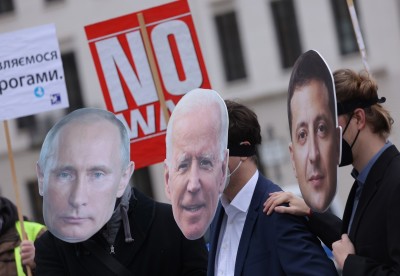Russian military culminates into new 'phase' in Ukraine

One of the many pitfalls of Russia’s invasion of Ukraine is the world’s reassessment of the Russian military and the resulting loss of prestige. Though the Russian economy is only around an eighth that of the United States, Russia has poured an excessive percentage of its GDP into defense spending, around 4.3%.
This totaled over $60 billion and puts Russia at the highest defense spending (by GDP) among the world’s major industrial powers. In comparison, Germany spends only 1.4% and China spends only 1.7%. Additionally, the Russian military was seemingly experienced, as it had deployed operationally over the last two decades in various locations outside Russia: Chechnya, Georgia, Crimea, the Donbass, and Syria. But the Russian invasion in Ukraine has drastically underperformed compared to what most intelligence assessments of Russian conventional military capability had assumed.
Despite the fog of war, the facts on the ground show that Russia led the invasion with its most capable forces and equipment, and yet failed. That, and a Russian shift in war aims, shows a likely culmination of Russian forces. It remains to be seen whether this means we’ll have a stalemate or an end to the conflict. Let me explain.
First, early Russian failures included most of the battlefield operating systems, particularly logistics and maneuver. Putin had made clear that the invasion of Ukraine, or “special operations” as he called it, was for the complete seizure of the country to install a puppet government. He said, “for this we will strive for the demilitarization and denazification of Ukraine.” And to the Ukrainian military, Putin said, “I urge you to immediately lay down your weapons and go home. All servicemen of the Ukrainian army who fulfill this demand will be able to freely leave the combat zone.”
Putin’s invasion came on multiple fronts and included amassing forces to seize the capital, Kyiv. However, this invasion quickly sputtered out on multiple fronts, in particular the advance from Belarus to Kyiv. Many Russian armored vehicles ran out of fuel, got stuck in the mud, or were destroyed by Ukrainian infantry and drones. The only seeming successes were near Crimea and Donbass, where the Russian logistical lines were quite short. Their focus has shifted to primarily killing civilians.
A culmination comes when a military force has “spent” itself in resources and casualties to the point it cannot continue its mission. Some have theorized that Russia deployed less capable forces early in the invasion and has held back its main forces — but that claim makes little sense from what we know.
To achieve success in any offensive operation, surprise and speed in maneuver are the critical components. The attacking force needs to move combat power quickly to the decisive point before the enemy can develop defenses to stop the advance. Success is predicated upon speed with the most capable combat power possible. In other words, you need your best troops leading off any invasion for success, and that is what we have seen. Over 800 Russian vehicles were destroyed in the first few weeks of the invasion (versus around a quarter of that number in Ukrainian vehicles). The destroyed Russian tanks and infantry carriers in Ukraine are the latest and best models of vehicles. The units involved are top Russian units with a lower number of conscripts than most others. This is what we would have expected.
By the known data, the numerically smaller Ukrainian “David” has been demolishing the behemoth Russian “Goliath” since the start of the invasion. To take a prime example, while Russia has lost a conservatively estimated 274 tanks, the Ukrainians have actually gained in numbers of tanks due to the capture of Russian tanks. According to Forbes: “Ukraine has lost at least 74 tanks … but Ukraine has captured at least 117 Russian tanks.”
Despite the early 40-mile convoy of vehicles backed up outside Kyiv, Ukrainians are now on the offensive against Russia and have retaken ground both east and west of Kyiv. As I write this, approximately 10,000 Russian soldiers sent to complete the encirclement of Kyiv are now likely encircled by Ukrainians. Because of these changes, Russian troops around Kyiv are digging defensive positions.
Due to these reverses, Russia has now had to “reframe” its stated aims. According to Sergei Rudskoy, head of the Russian General Staff's Main Operational Directorate, “The combat potential of the armed forces of Ukraine has been considerably reduced, which ... makes it possible to focus our core efforts on achieving the main goal, the liberation of Donbass.”
The focus to “demilitarize and denazify” Ukraine is now “liberation of Donbass.” This shows an operational culmination of the originally stated aims involving all of Ukraine, not just the eastern region.
Based on Russia’s history in Chechnya and Aleppo, there is a danger that this “special operation” could continue past a Russian offensive, with Russia pounding civilians with artillery in frustration. However, the difference is the present international sanctions are causing great economic pain to Russia. That, and the continued depletion of the best of Russia’s military may make a difference in leading Putin to leave now.
Proverbs 29:6 tells us: “The evil fall into their own traps.” It appears Putin has culminated in his invasion of Ukraine and may have fallen into the trap he set. Let’s pray wisdom prevails with his next decision.
Bill Connor, a retired Army Infantry colonel, author and Orangeburg attorney, has deployed multiple times to the Middle East. Connor was the senior U.S. military adviser to Afghan forces in Helmand Province, where he received the Bronze Star. A Citadel graduate with a JD from USC, he is also a Distinguished Graduate of the U.S. Army War College, earning his master of strategic studies. He is the author of the book Articles from War.





















